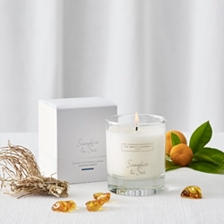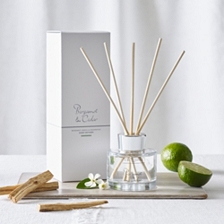So begins Harold McGee in his award-winning book, Nose Dive: A Field Guide To The World’s Smells. With encyclopaedic detail, he maps our understanding of the universe in fragrant form, tracing individual aroma chemical compounds that construct the world we live in. I highly recommend reading, but for daily wonderment, all you need to do is follow your nose.
When we inhale, that infinite galaxy of minuscule molecules is detected by olfactory receptors which immediately stimulate one of the deepest, most evolutionary ancient parts of the brain: the limbic system. This area deals with survival instincts and emotional reactions, and it’s here our unique database of scent memories is stored. Internally, this invisible communication takes place in a split second, the olfactory ‘bulb’ in our nose an initial relay station to sensorial sensation – several thousand neurons firing to create an odour map of understanding.
As cave-dwellers we used this to detect the scent of a predator, determine if a plant was edible, and even, it is believed, to find a mate with sufficient differences in their immune system to increase the likelihood of disease-resistance in offspring. Today, we might only consciously use these inherent powers to cautiously sniff the milk, or casually find ourselves preferring one scent to another. But olfactory maps can be externalised, too.
Dr Kate McLean is a lecturer, artist and designer who works within “…the intersection of human-perceived smellscapes, cartography and the communication of ‘eye-invisible’ sensed data”. More basically put, she makes maps of smells, leading groups of researchers in cities around the world to record the aromas. It’s an intellectualised version of what you’ve been doing from the moment you got out of bed this morning, without even realising it. We punctuate our days with this internal understanding; the silver-y smell of dawn’s crisp air, a whisp of woodsmoke and the dry, musky sweetness of the first fallen leaves (caused by their sugar compounds breaking down) on a woodland floor presaging autumn’s arrival.
This nose-led nostalgia increases when autumn approaches – in hot weather, scent molecules evaporate more quickly, meaning smells are fleeting. In wintery weather, those smells are flattened, our noses numbed. So autumn is the best season for savouring scents – that woody, mushroom-y, mulchy aroma, borne aloft on a breeze carrying the scent of a bonfire many miles away. Of course, I’m romanticising, and the reality (certainly here in the U.K.) can be grey drizzle; but oh, those golden autumn days make the world seem kinder, somehow. I find myself breathing deeper, feel my lungs expanding with the pleasure of using my nose. And it’s no mere coincidence we feel better after that walk – the Japanese have long referred to ‘shinrin-yoku’ [forest bathing], a sensation now proven to be linked to the ‘biophilia effect’ of the smell of trees, shown to calm and rapidly increase healing rates.
On an autumnal afternoon, perhaps you encounter a passing stranger’s scent trail which rocks you back on your heels – a sudden flood of fragrant memories: someone you’ve not thought of in years, a happy holiday destination, or the signature scent of a loved one, lost. Maybe later you enter a cosy second-hand bookshop – the comforting smell created by slowly decaying paper releasing woody-vanilla notes, which have been shown to be more calming than lavender, soothing our inbuilt startle reflex (and being trialled by some hospitals for patients undergoing stressful procedures). Perhaps that evening you squeeze some lemon into a butternut squash soup or pop a slice into a hot toddy – that zingy citrus scent revealed to be immediately reviving, even helping participants in a study at the University of Brighton feel better about their body image. The spices you add may trigger feelings of being nurtured, warmed inside and out; while eating succulent, seasonal fruits evoke the mellow, honeyed air of an orchard blushed by sunset.
These unbidden reactions are the olfactory memory map in action, latent emotions responding to the smell and ringing a remembrance deep in your soul. Indeed, some scientists believe aroma molecules vibrate at differing frequencies – the way we feel a gong resounding in our solar plexus – while others argue they slot into our scent receptors according to shape. While much research continues, being mindful of what we’re smelling, and (more importantly) how it makes us feel, is a modern alchemy we can all benefit from.
















